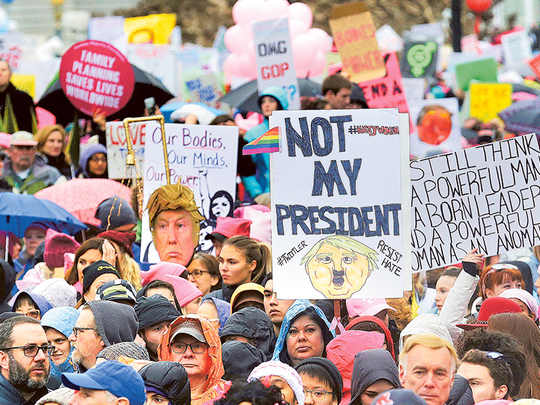
Washington: More than 1 million people who turned out Saturday for women’s marches in all 50 states have put down their placards, taken off their pink hats and ended their chants after what was an extraordinary display of dissent against the Trump presidency.
A critical question remains: What happens now?
The challenge facing the organisers is how to channel the resolve and outrage of an organic protest into action that produces political change. That goal has eluded other popular movements, from Occupy Wall Street to Black Lives Matter. It is no less daunting now, given that Democrats were unable to defeat President Donald Trump in 2016 despite an emerging demographic majority.
The organisers are trying. Within minutes after the march in Washington ended at sundown Saturday, its leaders convened a four-hour pep rally and networking session called “Where Do We Go From Here?” On Sunday, Planned Parenthood held a training session for 2,000 organisers on turning mobilisation into political action, with health care atop its priority list. David Brock, the Democratic activist, assembled a group of about 120 leading liberal donors in Aventura, Florida, to hear plans for lawsuits and other challenges to Trump.
Past movements rallied around one unifying cause: the Vietnam War, civil rights, the government bailouts and spending that helped create the Tea Party. On Saturday, marchers and liberal activists embraced a vast array of issues, from reproductive rights to mass incarceration to environmental activism, raising questions about how to create a cohesive movement.
But the leaders believe that the common thread — revulsion and contempt for the man who is president — may be powerful enough.
“Trump is the cure here,” said Democrat senator Jeff Merkley, a supporter of Senator Bernie Sanders of Vermont during the Democratic primary who was invited to Brock’s conference. “He brings everybody together.”
Cecile Richards, president of Planned Parenthood, a sponsor of the marches, saw another rallying cry: “Women in America are not going back.”
Ai-jen Poo, director of the National Domestic Workers Alliance, one of many partner groups of the march, said that organisers intended to study the protests in all 50 states to identify issues and recruit volunteers to gear up for the 2018 midterm elections. In Washington at the post-march panel, Planned Parenthood held a mass call-in event, where participants called their senators and urged them to protect their access to health care.
Todd Gitlin, a former president of Students for a Democratic Society and a scholar of political movements, noted that the civil rights and anti-war movements succeeded because of the organised networks that preceded and followed any single mass protest.
“The march on Washington in 1963 was the culmination of years of local activism, including civil disobedience, registering voters, protecting civil rights workers and voter education movements,” he said. “Organisations need to be ready to receive the protesters when they’re ready to take the next step. You need to be a full service movement.”
That effort, the organisers say, is underway. At the panel Saturday night, representatives from the partner groups made 90-second pitches to the marchers urging them to sign up for any of the organisations that appealed to them. The key, Poo said, was to build a continuous relationship with voters and volunteers so that they are not only approached before elections.
Tresa Undem, a partner in the polling firm PerryUndem, said that several years of convening focus groups had convinced her that women’s issues can translate into political momentum. When she showed focus groups a list of specific restrictions on abortion and health care that had been passed on the local level, she said they immediately began talking about how men were making those decisions. A poll she conducted that was released this month found that outrage at Trump’s remarks was the primary predictor of whether women would take specific political actions.
Still, the women’s movement faces several potential obstacles.
Leaders believe the only way to mobilise is to sweep in disparate groups, which can risk diluting their message. And the wounds inflicted by the election still run deep. Minority women in particular say they are concerned that the new attention to the white working class might mean de-emphasising issues of race for fear of alienating white voters.
“The coalition for Obama was never sustained after the election,” said Kimberlé Williams Crenshaw, a professor of law at Columbia University and the University of California, Los Angeles. “There’s been a failure to engage the base.”
Attention to specific causes has not always translated into votes on the local level, where Republicans have won statehouses and governorships. Democrats need look no further than the last eight years to find a cautionary tale about what happens when the excitement over a national movement — Barack Obama and his historic presidency — is not sustained in midterm elections.
“In many parts of the country, the Democratic Party is a shell,” Gitlin said.
Concern over this atrophy is what is prompting so many Democratic officials — including Obama and Eric Holder, his former attorney general — to urge donors and activists to direct their time and money toward unglamorous causes such as redistricting and statehouse races.
The urgency of the Trump presidency, the organisers say, may help bridge the party’s divides. “We together have to have the resources and creativity enough to solve problems for all of us,” Poo said. “There’s a lot of work to do to get there.”












